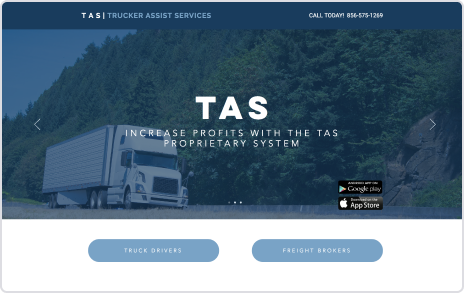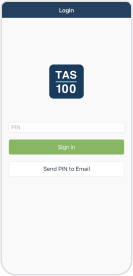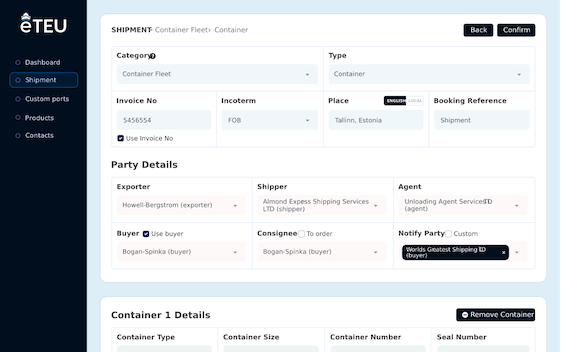Get the best AI-powered order management software tailored for your internal operations. Experience the benefits of seamless integration with various intelligent automation features and legacy systems.
Consulting
We can consult on constructing a practical and beneficial technical solution for your product.
Custom software
We deliver highly specialized, cutting-edge solutions for all niches of the logistics industry.
Dedicated teams
Jumpstart your long-term projects with a team of hand-picked professionals powered by AI.
Services
Technologies
- Adexin
- Services
- Custom software
- Order management systems development
AI-powered order management systems development
Where we can help
We have expertise in developing AI-driven custom software for order management. Get the best smart work order management software to enhance your distribution capabilities through machine learning.
Order fulfillment
We create solutions to support AI-enhanced order fulfillment with a user-friendly interface compatible with mobile devices. You can integrate barcode readers for fast and accurate fulfillment. You can use AI pick-path navigation to optimize the order fulfillment process. This feature allows you to plan outbound logistics efficiently, considering factors such as shipping methods and delivery times through algorithmic automation.
Order planning
We create functions to plan orders effectively. With our industry knowledge, we consider lead times and resource availability. You can dynamically create picking lists to optimize order processing. You can also receive a customized solution for a customer portal powered by predictive AI planning for transparent order tracking and communication.
Traceability of orders
We provide you with a comprehensive traceability system that allows you to track goods from arrival to delivery. You can provide your customers with proof of delivery (POD) to confirm the successful completion of the order. We can integrate the marking and labeling of goods into your AI OMS system for easy identification and tracking through computer vision.
Payment processing
We offer an integrated feature for a secure payment gateway for smooth and reliable financial transactions. You can equip your business with automated invoicing to reduce manual errors and increase efficiency. In addition, we can implement a system to track payment status and manage invoice disputes with AI fraud detection. We can develop a refund management solution for seamless processing.
Analytics and Reporting
Our development services include interactive dashboards to quickly overview key performance indicators (KPIs). We can provide you with the tools to create detailed annual reports and benchmark against industry standards. This leads to AI-based predictive analytics capabilities that help forecast demand and operational optimization.
Returns management
We are developing a user-friendly returns system with tracking capabilities. With this feature, you can streamline the refund process to increase customer satisfaction and loyalty. You can control the level of transparency and get higher-quality data on business operations and loss of control through AI-powered insights.
Integration
We ensure seamless integration with other customer systems for real-time data exchange and with systems such as WMS, TMS, and DMS. With our development services, you can minimize errors and improve efficiency through synchronized information flow and AI data automation.
Inventory management
We develop system features to effectively manage inventory by minimizing inventory obsolescence and optimizing warehouse space. We can implement RFID barcode technology for accurate and automated inventory control. We offer support for mobile devices to update inventory data on the go with AI inventory forecasting.
Purchase management software
We offer software development for purchase management systems that can be seamlessly connected to customer databases to retrieve and update order information in real-time. You can enable manual order adjustments to respond flexibly to customer requirements. Such an AI-enhanced OMS feature developed on demand as part of our service allows you to streamline order approval workflows and provide an intuitive order cancellation system.
Shipping management
We customize your shipping process by implementing different shipping models for processing. You can efficiently manage dropshipping processes within the order management system. You can streamline last-mile fulfillment to ensure on-time and accurate deliveries. We can implement freight management capabilities and work with carriers to find optimized shipping solutions using AI routing optimization. Finally, you can enable your operation to adopt cost-efficient and environmentally friendly shipping practices through order consolidation.
Our case studies
Here are selected projects developed by the team that have delivered higher efficiency in day-to-day operations to our customers.
Truck owners assistance application
Shipping document management platform
Industries
We excel in providing the most advanced order management software (OMS) tailored to specific industries in our respective sectors. As industry experts, we focus on key aspects of business operations.
Logistics
Integrate OMS custom software with your warehouse and distribution operations. Get seamless order fulfillment, inventory management, and other functions. Get better data insight and real-time visibility in a fully integrated solution.
Transportation
Integrate your outbound operations with your OMS and get seamless shipment management and more efficient overall transportation operations. Control your outbound operations in real-time and optimize your entire freight transportation process. Take advantage of reduced transportation costs and gain a competitive advantage with our OMS custom software.
Supply Chain
Increase your supply chain network with more accurate distribution processes. Gain better visibility and absolute control over your supply chain management. Optimize transportation processes, inventory levels, and shipments. Reduce fulfillment times and foster process adaptability through data-driven decision making.
Why Adexin
A unique symbiosis of education, AI expertise, and practical experience helps our company solve customer satisfaction tasks with top quality.
Adexin Tools
We leverage our proprietary AI-driven Adexin Tools, a ready-made codebase built on our industrial expertise, to accelerate project launches and cut development time by up to 5 times. It includes solutions for data management and outdoor tracking.
Expert group
Our AI-powered expert group offers direct access to top specialists who can assist with technical and industry-specific challenges, quickly assembling and integrating dedicated teams for your projects.
Industrial focus
We continually enhance our logistics expertise, adopting AI and machine learning technologies to drive industry growth and deliver better results for our clients.
Effective process
Recognized by Clutch among the top logistics software developers, Adexin ensures high-quality solutions by aligning with client goals and maintaining consistency across all business processes.
Scalable solutions
We develop AI-driven logistics software with built-in scalability, enabling future growth and advanced predictive features at minimal cost.
Full-stack development
Our full-stack AI teams accelerate your digital transformation with faster time-to-market, improved efficiency, and enhanced customer service.
Adjustable process
We offer flexible contracts and adaptable processes to expand your teams, add new AI features, and optimize your final product as your needs evolve.
Cloud-based solutions
Cloud technology powers our AI-driven logistics solutions, enhancing agility, flexibility, performance, and innovation while reducing operational costs.
How AI-driven order management system can help
Custom software development for an order management system (OMS) can enhance operations by consolidating various functions into a standardized business solution. OMS software provides a holistic view of transportation, logistics, and supply chain processes.
Better customer service
An efficient order management process, from placing the order to receiving the service or products, ensures a smooth journey for customers. Using our customized OMS software, you can reduce disruptions and delays that can lead to better customer satisfaction and retention. A robust order management system reduces risk by meeting or exceeding customer expectations.
Controlled Inventory and Supply
Using global inventory control through an order management system provides real-time visibility. Customers have access to real-time inventory information, even across multiple locations. This feature can optimise decision-making, enabling companies to prioritize channels based on demand and margins, especially during peak sales.
Centralized management
Our custom OMS development services offer centralization of customer and order information, providing complete visibility into sales channels and distribution centers. All business representatives can respond more efficiently to inquiries regarding shipping, delivery, delays, or cancellations. This transparency in the shipping process aligns with customer expectations for updating and tracking information.
Omnichannel store fulfillment
We offer a build in function for various delivery options, from online purchase / in-store pickup to same-day shipping. This enhances customer satisfaction. You can enable your operations with omnichannel options such as shipping from store, shipping to store, and BOPIS. This provides flexibility. Endless concepts give customers access to global inventory, increasing convenience and choice.
Managing customer information
OMS makes it easy to store and reference customer information. Valuable customer profiles can be created and managed. This enables the company to better understand customer preferences and track order history (you can gain insight into geographic popularity, which helps you adjust marketing strategies). Data-driven activities provide a higher return on investment.
Data storage and backup
Digital storage of critical data minimizes the risk of losing important information. With digital data storage, you can switch to digital asides and reduce paperwork. With OMS software, you can create multiple backups that lessen the need for physical space and allow for easy recovery of critical data when needed.
Live inventory updates
OMS helps eliminate the risk of so-called out-of-stock. You get live inventory updates and can reorder goods at any time. OMS software enables you to track product levels across multiple warehouses and sales channels. It provides customers with accurate, real-time information, improving the shopping experience.
Smarter decision-making
OMS enables you to use customer information to make informed business decisions. It enables the identification of best-selling products and popular markets. OMS data allows for strategic planning and ensures brand relevance.
Crucial steps for most suitable custom order management software development
We come to you with custom software solutions that drive innovation in your industry.
- 1
Understanding needs
1 weekThis step usually includes a series of meetings between you and our teams to discuss your business needs and pains. Also, we suggest signing an NDA to protect your sensitive information.
- 2
Solution and estimation
1 weekWhen requirements are clear enough, our team of experts determines the best suitable solution and provides a rough estimation of required time and resources, based on their extensive experience.
- 3
Project planning
1 weekWhen we understand the scope of the project, we will jointly plan the budget, timeline, and team structure. Also, this phase includes drafting an official agreement.
- 4
Phase 1.0
~3-12 monthsAdexin strongly recommends determining which functions and features of the new custom software are critical for the business and need to be implemented and tested in the first place. This phase can also be called the MVP phase. Usually, we follow the Kanban methodology during the logistics software development process. This gives the project flexible planning, fast output, clear focus, and transparency during the development cycle. We apply a full-picture reporting approach to make sure all parties are clear about the progress. This approach includes each team member's daily status reports, the whole team's weekly reports, biweekly demos, and monthly invoicing.
- 5
Phase 1.0 test
~1-2 monthsGetting the initial feedback from real users is very important. Having an MVP helps you to test your assumptions and business model. It allows you to really understand how users use the software, what should be added, and what needs to be fixed in the next development process.
- 6
Phase 2.0 and more
as much as neededCongrats, your first test showed that the project is promising and worth expanding. We will be glad to continue working on your project and grow together. The next phases can contain advanced features, additional functions, and logic requested by your users.
We develop custom order management software to keep it simple and exactly right for our customers when handling orders within logistics, distribution, supply chains, and transportation operations. We are always improving our system to make sure it does its job well without high costs. We have been a leader in our niche for more than 10 years now.
Our approach is simple so that companies can easily deal with challenges in an ever-changing business environment. With our flexible system, we can adjust things as needed. You can rely on our flexibility and adaptable approach. At Adexin, our teams are here to support your business and adapt to what you need, keeping everything simple and practical.

Book a free consultation to discuss your project
Our certifications in logistics
FAQ
Below, we answer the most important questions about developing custom order management software. See the key factors that help implement and facilitate custom software development for OMS systems. Learn more about what will help your company become more successful.
What is an OMS (Order Management System) in software development?
An order management system (OMS) in software development is a tool that helps companies efficiently handle and process orders. Here are the areas of OMS:
Automated tracking
OMS is a software system that automates tracking sales, orders, inventory, and fulfillment processes.
End-to-end capabilities
Includes functions for managing customer orders from initiation to fulfillment, offering an end-to-end solution.
Improving efficiency
Streamlines the entire order lifecycle, delivering efficiency by automating tedious manual steps.
Preparing for business expansion
Implementing an OMS prepares companies for sales growth as they scale by handling various aspects of order management.
What does an order management system do?
An order management system helps companies manage orders by tracking and organizing them throughout the process. It typically includes order entry, inventory management, processing, and fulfillment. Here are summarized main functionalities:
Order processing
OMS facilitates efficient order processing from initiation to fulfillment. It manages the entire order lifecycle. This includes order creation, consolidation, modification, and cancellation.
Inventory management
OMS software helps track inventory levels in real-time. This allows the system to provide accurate information about product availability. This prevents over-selling or running out of stock in daily operations.
Integration with other systems
An OMS often integrates with various business systems, such as customer relationship management (CRM), supply chain management, and e-commerce platforms. Such integration streamlines data flow and increases overall operational efficiency.
Order tracking and reporting
OMS provides real-time order tracking tools. This enables companies to monitor the status of each order. It also generates reports and analysis, offering insights into sales performance, customer behavior, and inventory turnover. The system helps companies make informed decisions.
How do you develop OMS?
OMS development includes an analysis of the company's specific needs. The system architecture must be designed and include the necessary functions. This often includes coding, testing, and continuous improvement to ensure it meets the requirements. The best option is to contact experienced developers in your industry to get support in building such a solution. Here are selected requirements for OMS system development:
Needs assessment
The development process begins with thoroughly analyzing the company's requirements and needs for order processing, inventory management, and order fulfillment. This includes an analysis of interrelated networks.
Architecture design
This aspect refers to the design of a robust system architecture that aligns with specific business needs. This is where skilled developers who understand the specifics of the industry come in. This includes outlining the structure and components of the order management system (OMS) to ensure scalability and performance.
Implementation process
The development team implements key functions such as order entry, inventory tracking, and order processing and integrates side systems for better collaboration. Coding and programming are carried out to bring these functions to life, focusing on meeting specific business requirements.
Continuous improvement
Continuous improvement is crucial to OMS development. It is important both before and after the development process. Regular testing, feedback collection, and updates are carried out to ensure that the system evolves with changing business dynamics and optimizes the order management process effectively.
How do you create order management?
Creating an effective order management system involves designing a comprehensive workflow that includes both order initiation and order fulfillment. This process includes developing a user-friendly interface that facilitates smooth interaction. The development team must implement key functions such as order tracking and inventory management, the ordering system, and more. The implementation phase ensures a smooth transition to the new operating environment. At the same time, full user training should be considered to maximize system utilization and increase staff productivity. User feedback should be continuously monitored and tracked, and iterative improvements that contribute to long-term system performance should be made.
How do you implement order management?
Order management implementation includes installation and configuration of OMS software for off-the-shelf (COTS) solutions. Nevertheless, the way forward after the development process remains similar. You can also choose custom software, which starts with the development process. Programmers must prepare integration with existing systems and user training. The process will also include a gradual transition to the new system. Continuous monitoring is required to ensure smooth operation and adaptation to changing business needs.
Custom development
Custom development plays a key role in getting the most optimized order management systems to meet the unique needs of logistics, supply chain and transportation operations. Your process can start with software development and then move through specific steps to deploy the solution in-house.
Installation and configuration
Begin by installing and configuring the Order Management System (OMS) software, and developers must tailor it to the company's specific requirements and infrastructure.
Integration
Your custom software company must ensure a smooth transition by integrating the OMS with the company's existing systems. This includes connecting the new system to other software solutions, databases, and platforms to ensure seamless data exchange and workflow continuity.
User training
Make sure you can conduct comprehensive training sessions for users to familiarize them with the features of the new order management system. This step is crucial to ensure that team members can effectively navigate and use the system in their daily tasks.
Continuous monitoring
Make sure there is a strategy for implementing continuous monitoring of system performance. Regularly evaluate its functionality and resolve any issues that arise on the way. Optimize the system based on actual usage and changing business requirements. This proactive approach ensures the long-term performance and effectiveness of the implemented order management solution.
How much does an OMS software cost?
The cost of Order Management System (OMS) software can vary significantly depending on several factors. These include vendor specifics, features offered, company size, and complexity of integration. The most cost-effective way to acquire software is through custom software development, where you can get flexible customizations. Here are some elements for deeper consideration:
Company size
Small companies may find more affordable options with basic features, while larger companies with greater needs may choose robust enterprise-level solutions. These will be more expensive.
Features and personalization
The more features and customization options the software offers, the higher the cost. Advanced features such as real-time analytics or advanced reporting and seamless integration with other business systems can contribute to higher prices. It all depends on your business model.
Licensing model
Many OMS software providers offer a subscription-based pricing model in which companies pay a recurring fee. In contrast, others may require a one-time upfront payment or a combination. In many cases, companies are choosing custom OMS software development, which allows them to get best-in-class dedicated systems for their operations.
Implementation and support services
Costs may also include implementation, training, and ongoing support services. These services are critical to the successful implementation and effective use of the OMS in the future.
Is a custom order management system better?
Determining whether a custom order management system (OMS) is better for your business depends on various factors. We defined here some advantages and disadvantages to consider.
Custom software disadvantage:
Development time
Custom solutions usually take longer to develop and implement than off-the-shelf solutions. However, it can bring tangible long-term benefits and reduce the time required to perform daily repetitive tasks.
Dependence on developers
By outsourcing the construction and maintenance of a system to a team or individual responsible for custom software, you may become dependent on them. This can be a problem if there are changes in the development team or if ongoing support is not well established.
Updates and maintenance
Regular updates and maintenance often become a company responsibility. This may require additional resources and expertise but can still be outsourced to a software partner.
Custom software advantages:
Customized to meet your business needs
A custom OMS can be developed to meet your company's specific requirements and workflows. This ensures that the system suits your unique processes and goals.
Scalability
Custom solutions can be designed with scalability in mind. It allows them to grow and adapt as your business grows. This can be especially beneficial for companies experiencing rapid growth.
Integration
Custom OMS systems can be seamlessly integrated with existing CRM, e-commerce platforms, WMS, TMS, and DMS systems. This integration ensures a seamless flow of data between different business functions.
What are the features of an order management system?
An effective order management system (OMS) typically includes several features. Here are the key features commonly found in OMS:
Order processing
Order creation, modification, cancellation, and consolidation: users can create new orders manually or automatically and adjust them at a specific time.
Inventory management
Real-time inventory tracking provides accurate and up-to-date information on product availability. It can also include inventory alerts that notify you when stock levels are low, or items are out of stock.
Integration
Integration with various sales channels, including e-commerce platforms, marketplaces, and retail stores.
Order processing
Picking and packing optimize the picking and packing processes to prepare orders for shipping. There is also shipping integration with carriers to automate shipping processes and generate tracking information.
Customer information
Customer information, order history, and preferences are stored in customer profiles.This improves customer communication and makes communicating with customers about order status, shipping updates, and other relevant information easier.
Reports and analytics
Order traceability enables real-time tracking of order status throughout the fulfillment process.
Returns Management
Return authorization manages the returns process by efficiently authorizing and processing returns.
How can an order management system be integrated?
Order management systems (OMS) can be integrated with various other systems and platforms to ensure seamless data flow and operational efficiency. Here are the common integration points for an OMS:
Platforms for e-commerce
Integration with online marketplaces Connects with popular e-commerce platforms such as Shopify, Magento, WooCommerce, and others. It is about synchronizing product lists, prices, and order information.
Customer relationship management (CRM) systems
CRM integrations such as Salesforce or HubSpot are important for synchronizing customer data, order history, and communication records.
Enterprise resource planning (ERP) systems
ERP integration is one of the most popular systems and helps share information related to inventory, finance, and other business processes to get a holistic view of operations.
Payment gateways
Integration with payment processors such as PayPal, Stripe, or Square helps securely process online payments and update order status. OMS software can also be integrated with a document management system (DMS) that supports B2B financial processes, such as invoices and disputes.
What are the benefits of the OMS system?
The order management system (OMS) offers companies several advantages. Here are the main advantages of using an OMS:
Improved efficiency
OMS automates and streamlines order processing. It reduces manual tasks and minimizes errors.
Increased customer satisfaction
Ensures accurate and timely order fulfillment. That results in higher customer satisfaction.
Real-time order tracking
Provides customers with real-time updates on their order status. This improves transparency and communication.
Real-time inventory visibility
Provides real-time visibility of stock levels, reducing the risk of stock-outs or overstocks.
Demand forecasting
Helps companies forecast demand and optimize inventory levels based on historical data.
Multi-channel management
Manages orders from different sales channels (online stores, marketplaces, brick-and-mortar stores) in a centralized system.


